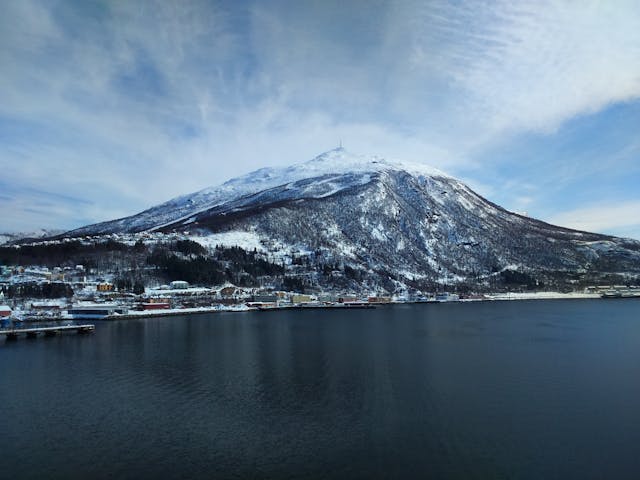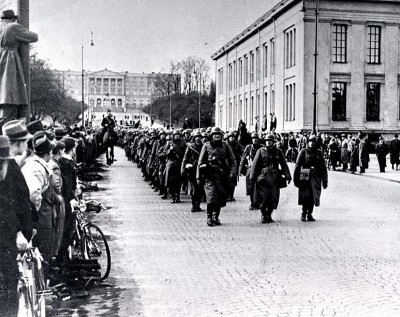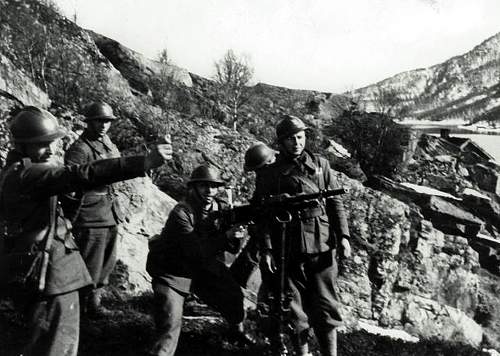
The battle of Narvik occurred from 9 April to 8 June 1940. This battle was a part of many battles during the German invasion of Norway and also the second world war. Narvik region provided an ice-free harbor, which is a suitable place to transport iron ore from Sweden. Due to this fact, The British and the Germans had the same interest in securing this important route for their iron supply. Additionally, the British believed by securing this region, they could use Narvik as the landing point to aid Finland in the winter war.
The allied consisted of the British, French, Norwegians, and Poles united under 1 command to protect Narvik and to repel the invasion. On the other hand, the Germans stood by themselves during this campaign. The battle of Narvik is acknowledged by many as one of the biggest battles since the invasion of Poland back in 1939.
The Early Stage of the German Invasion
The German navy, despite its small size, possessed modern vessels launched between 1935 and 1938. The Germans deployed 10 destroyers along with 2000 gebirgsjäger (Mountain troops), 1000 Fallschirmjägers (paratroopers), and 2,600 sailors. On the other side, the Norwegian possess only 2 obsolete coastal defense warships. The German flotilla approached the Fjord and quickly sunk the 2 Norwegian warships. With 2 of their largest ship sunk and 276 dead, the Norwegians have nothing to defend Narvik.
The Germans rapidly captured the surviving patrol ships and 1 submarine at the Norwegian base. Looking at their navy destroyed by the Germans, the Norwegian land forces quickly disorganized and retreated from Narvik. This quickly signifies the fall of Narvik to the German hands. Despite their victory, the Germans have a new issue and their celebration did not last. The destroyers aiding the invasion were running out of fuel. Without enough fuel, these destroyers could not make it out of Narvik and return to Germany. On the other hand, the British successfully sunk one of the tanker ships that were sent to Narvik.

The Naval Battle in Ofotfjord
The British Navy commanded by Captain Bernard Armitage Warburton-Lee approached Narvik. With only 4 destroyers, the British decided to attack 10 German destroyers around Narvik. The plan of the attack considered to be risky, since the German destroyers outnumbered the British. Also, the Germans were better armed.
First Naval Battle of Narvik
Only a day after the German invasion of Narvik, the Royal Navy launched an assault on the Kriegsmarine. At 4.30 am, the attack officially began. The destroyers from both sides traded salvos and torpedoes with each other. An hour later, the British officials agreed to pursue the remaining enemies and plan for a final attack on the remaining Germans. The British counted that they successfully destroyed 5 to 6 destroyers surrounding Narvik. But they did not know the Germans had 10 destroyers, not 6.

Warburton-Lee led his destroyers into the Narvik harbor and passed the burning German destroyers. All of the sudden, the untouched German destroyers greeted the Royal navy with gunfire and torpedoes. The British destroyers raised their speed to flee Narvik. The last message sent by Warburton-Lee at 5.55 am, “keep on engaging the enemy”. Moments later, his ship was struck by German shells. Everyone stationed on the ship’s bridge was killed, including Captain Warburton-Lee himself.
Despite his death, Warburton-Lee’s received Britain’s first Victoria Cross of world war II. Most importantly, his action led to the beginning of the destruction of the Kriegsmarine’s fleet in Narvik. In the first engagement, the British lost 2 of their destroyers. On the other hand, the Germans lost 6 out of 10 destroyers that were stationed in Narvik.
Second Naval Battle of Narvik

The first battle of Narvik was not the end. By April 11, the British sent another 11 destroyers to put an end to the 8 remaining German destroyers. At this moment, the Germans only had 4 undamaged destroyers with the other 4 destroyers damaged from the previous battle. The command center in Berlin realized that half of the German destroyers were trapped in Narvik. To make things worse, these trapped ships have no fuel, air support, and ammunition to fight back.
The second battle officially commenced on April 12 at 6 pm. Under new command, captain William Whitworth sent an order to his armada to put a final blow on the enemy. In the ensuing battle, 3 German destroyers were immediately sunk by the British. On the other hand, the other 5 destroyers were scuttled by their own crews when they ran out of ammunition.
The loss of the 10 destroyers had a direct impact and crippled the Kriegsmarine fighting capabilities. This defeat destroyed nearly 50% of the Germans destroyer force. Also, this victory made the Germans to be less aggressive with their navy and other battle situations. During this battle, no British destroyers were sunk, but most of them received minor damage.
The Land Battle at Narvik
With total control of the sea, the allied forces have more freedom to take the next initiative. However, the allied forces were too timid and did not take this advantage to take aggressive action. On the other hand, the German troops around Narvik were lacking supplies and support from the navy. This situation compelled them to be isolated and made their position stretched during the battle. Even before the British and French support in Narvik, German forces under General Dietl were outnumbered by the Norwegian troops in the area.

Against all odds, the Germans possess only 5,600 armies (Consisting of surviving sailors, mountain troops, and paratroopers). Meanwhile, the allied troops had 24,000 armies ready to take Narvik. Finally, the first attack happened on May 12, when 2 French foreign legionnaires landed in Bjerkvik and Elvegaard. During this attack, they successfully recaptured the Norwegian army depot and cut the supply route for the Germans. Later on, some Polish units and Norwegian ski troops joined the action to catch the retreating German forces.
The attack led by the French, Polish, and Norwegian troops quickly corner the defending force. General Dietl’s perimeter had now diminished to only the Northern and Southern parts of Narvik. However, the battle is not over. On the other side of Narvik, the British were preparing an amphibious landing that could threaten the remaining German troops.
The British Joined the Party
Not long after the French success, the British initiated an amphibious landing on May 12 with the help of air support. During this landing, the British totally gain control of both sea and air superiority, which make their advance to be swift and rapid. These advantages cornered general Dietl’s position and his troops.
On May 27, the final assault of Narvik finally began by the British and French forces. After a brief fight on the beachhead, they advance rapidly and enter Narvik on the same day. Despite their success, they found that the German defenders have abandoned Narvik. During this moment, the situation for the German defender was grim. The only options for the Germans are only to surrender or make a retreat to neutral Sweden. At last, the allied troops were able to achieve their first major victory on land since the invasion of Poland back in 1939.
Who won the Battle of Narvik?

Despite the allied success in recapturing Narvik, General Dietl technically won the battle by holding the allied forces as long as he can. The allied success in Norway was overshadowed by the event happening in France at the time. On May 28, the German troops in France successfully defeat the allied troops and surround 400,000 British and French forces in Dunkirk. Also during this time, the evacuation of Dunkirk was ongoing.
The British realized that their home islands were undefended. Especially with their forces that were deployed in Norway and trapped in France. Reacting to this condition, the allied troops hurriedly evacuate their troops from Norway to be sent back home. With no allied support, the victory at Narvik only lasted short. On June 7, a Norwegian representative under General Otto Ruge visited General Dietl and negotiate the Norwegian surrender to the Germans.
The allied troops achieved an indisputable naval and land victory at Narvik. However, they were not able to capitalize on these advantages by not taking more aggressive action. If the allied troops could take Narvik earlier, the geopolitical condition in the Scandinavian region would change and give them more advantages in the future. One of the advantages they could achieve is to control the iron ore supply from Sweden and disrupt the German logistic supply throughout the war. Nonetheless, the loss and damage to the German equipment during the Narvik campaign were considered significant and important for the allies throughout the remainder of the second world war.
Further Read
https://www.royalcourt.no/nyhet.html?tid=127971&sek=27262
https://warfarehistorynetwork.com/article/the-battle-of-narvik-crippling-the-kriegsmarine/
https://www.lifeinnorway.net/battle-of-narvik/
https://totallyhistory.com/battle-of-narvik/
https://warfarehistorynetwork.com/the-battles-of-narvik-the-norwegian-campaign/
